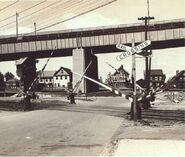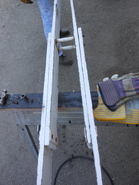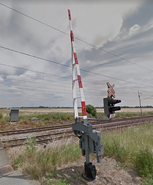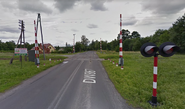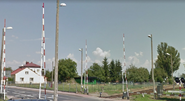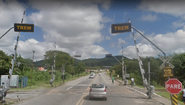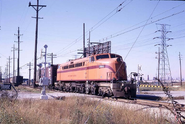Bio[]
A "wishbone crossing gate", or just for simplicity, a "wishbone gate" is a type of railroad crossing gate that has been used on various railroad or grade crossings.

Wishbone gate used at a railroad crossing. This one is red and white striped; one typically found on most railroad crossings installed between the 1960s to the early 1990s.
History[]
Wishbone gates, also known as A-gates, A-type gates, or A-frame gates, are one of the oldest types of crossing gates that have been used on grade crossings. These gates were typically made out of wood and were structured with two separate bottom sections that would meet toward the top, usually with a third section starting in-between the two bottom sections and continuing a ways upward by itself. Meanwhile, between the two bottom sections of the gate were braces connecting the latter. These types of gates have been in common use since the early 20th century. Now these types of gates are becoming more rare and have either been replaced by the more modern single-bar gate arms (made of aluminum, fiberglass, or both) on still-active or existing crossings, or have been eliminated altogether with the crossing due to crossing closure, grade separation (overpass or underpass), or a line going out of service.
Although the few remaining wishbone gates seen in the US today are red and white striped, the earlier ones were non-striped. Then later they were changed to black and white stripe, which has been used from the earlier days up until the 1960s. It is said that by 1973, black and white gates were replaced with red and white gates as per FRA regulations regarding night time crossing visibility. Wishbone gates also had their stripes painted black and yellow during the first-half of the 20th century (notably during the 1940s and 1950s. While the more modern bar-type gates started being used, some wishbone gates remained in service; though only the more common and modern red and white ones were active. Some wishbone gates were also black and yellow striped and one such railroad that used gates of this color was the Chicago South Shore and South Bend Railroad which operates from Chicago, Illinois to South Bend, Indiana, called the South Shore Line, which is owned by the Northern Indiana Commuter Transportation District (NICTD). Now all their crossing gates are equipped to meet modern standards, though they continued to utilize wishbone gates throughout the 1990s and up to the early 2000s. In the late 1990s, NICTD started replacing their wishbone gates with the more modern gates.
Western railroad carriers such as the Denver And Rio Grande Western (DRGW), Southern Pacific (SP), Western Pacific (WP), and the Union Pacific (UP) all once used various crossing signals before finally settling on the classic "wishbone" and (later) bar gates. Such examples of classic wishbone gates can be seen along the remnants of the once-active Tennessee Pass rail line through Colorado, as well as various ex-SP branchlines and mainlines scattered throughout the state of California.
Earlier wishbone gates were manually operated by a human watchman, who presided over the crossing, and would work in a street-side shanty and come out and crank down the gates. Then in 1936, the Western Railroad Supply Company, or W.R.R.S. (now Western Cullen Hayes) invented the first automatic crossing gate, which is now used with flashing red light signals, whether in the form of standard mast signals or cantilever signals.
Very few wishbone gates are still in use on crossings but are very hard to find. Some crossings in California still use wishbone gates but some are no longer operational due to line abandonment.
Lighting[]
In the earlier days, wishbone gates were lit with lantern type lights that would be placed above or below the gate. They also had lights that would extend upward from the gate itself and bend outward. Later, wishbone gates (as well as the bar-type gates), were lit with the circular gate lights that are still seen today at many crossings. Wishbone gates were either equipped with 4" gate lights or 7" gate lights. Other lights have been used on wishbone gates as well (including those lantern-type lights that extend from the gate arm itself and bend downward regardless of the gate's position.
Wishbone Gates Around The World[]
Wishbone gates have had common usage in the United States and, as mentioned, some American crossing gates retain their wishbone gates, but for the time being. Other countries, such as the United Kingdom, The Netherlands, The Czech Republic, Slovakia, Switzerland, Australia, Buenos Aires (province) in Argentina (at least in the city of Buenos Aires, and throughout Brazil to name a few) also use or have used wishbone gates at their crossings.
Gallery[]
Please include photos (and photos only) of any wishbone gates used at railroad crossings or displayed at railroad museums or anything railroad related (including your personal collection of wishbone gates.) Wishbone gates used at any given time are welcome. And please also post photos of wishbone gates used outside the U.s. (such as those used in the U.K, the Netherlands, the Czech Republic, Australia, Brazil, etc.) Photos only, no artwork. And there needs to be at least one wishbone gate in the photo.
Trivia/Facts[]
- Some wishbone gates were painted red and white, others used reflective red and white stripes.
- Black and white gates, including wishbone gates, are used in Brazil along with red and white gates, some of which are also wishbone gates!
References[]
Mike's Railroad Crossing Website http://www.rxrsignals.net
Western Cullen Hayes http://www.wch.com/
TrainOrders.com http://www.trainorders.com/discussion/read.php?11,1860877
Southern California Signal Fan https://californiasignalfan.wordpress.com/tag/grade-crossing/
Niles Canyon Railway Signal Department http://www.ncrysignal.com/crossings/kilkare-crossing
Whippany Railway Museum http://www.whippanyrailwaymuseum.net/exhibits/structures/railroad-crossing-gates-a-signals

